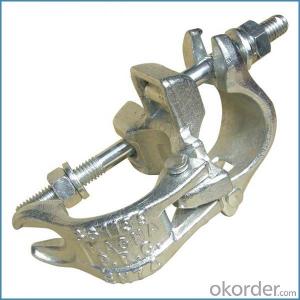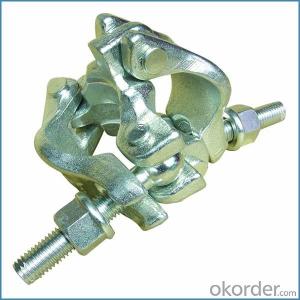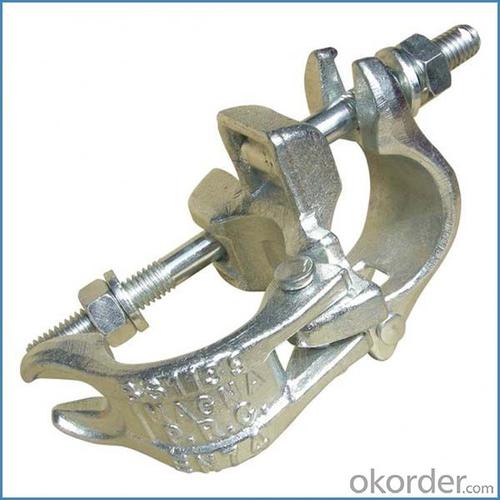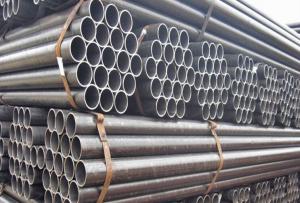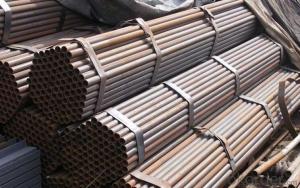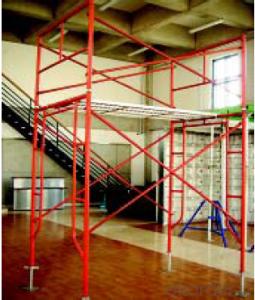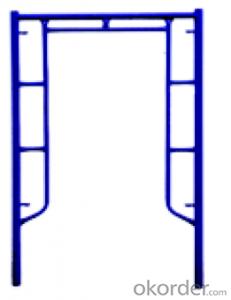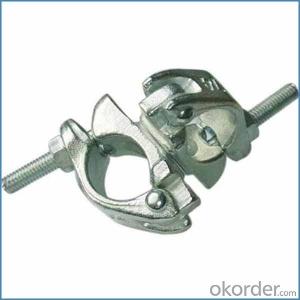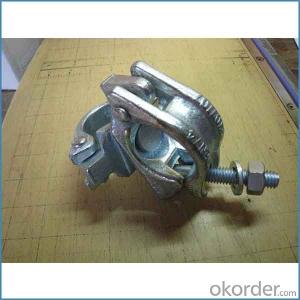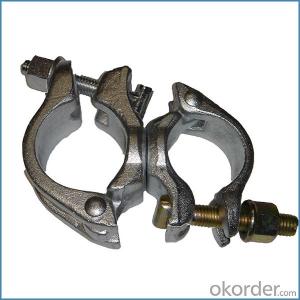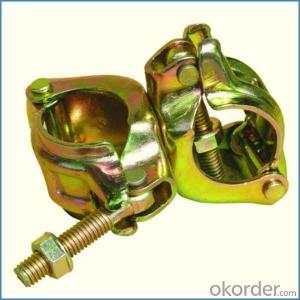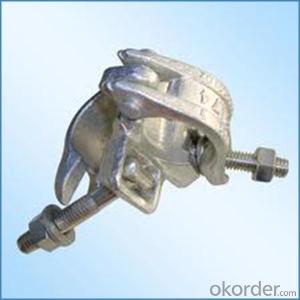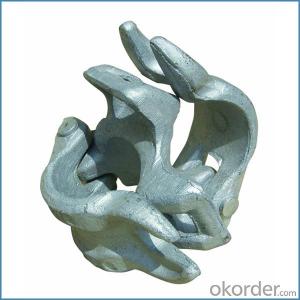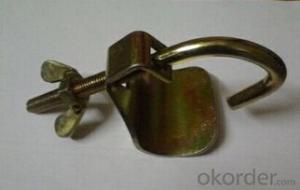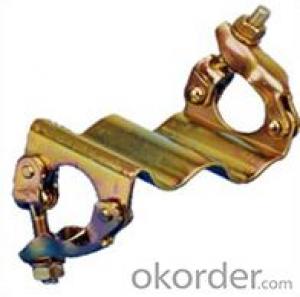Heavy Duty Swivel Coupler British Type for Sale
- Loading Port:
- Tianjin
- Payment Terms:
- TT OR LC
- Min Order Qty:
- 1000 kg
- Supply Capability:
- 100000 kg/month
OKorder Service Pledge
OKorder Financial Service
You Might Also Like
Heavy Duty Swivel Coupler British Type for Sale
Description
1.The scaffolding coupler is always used to connect the steel pipe as scaffolding system.
2.The often used coupler is swivel coupler and righ angle coupler .
3.We can provide types of scaffolding coupler according to your requirement.
4.Couoler can fix the 48.3mm scaffolding steel pipe tightly and make the whole scaffolding system more steadily.
5.Material:Q235 steel
6.Overall Size:48.3mm*48.3mm
7.Surface Finish: Galvanized/ Painted
8.Standard:BS1139,EN74
9.Package:25pcs/bag
10.Manufactuering as per customer requirements
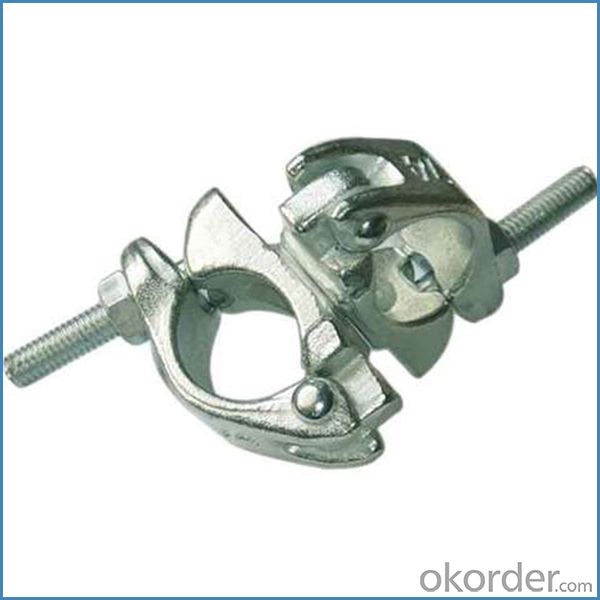
Feature
(1)Excellent Anti-Breaking—Cold Pressed Steel
(2)Outstanding Resistance Deformation
(3)Strong Anti-Dropping Ability
(4)Longtime USe
(5)Qualtity Guaranteed
(6)OEM Service
Photo

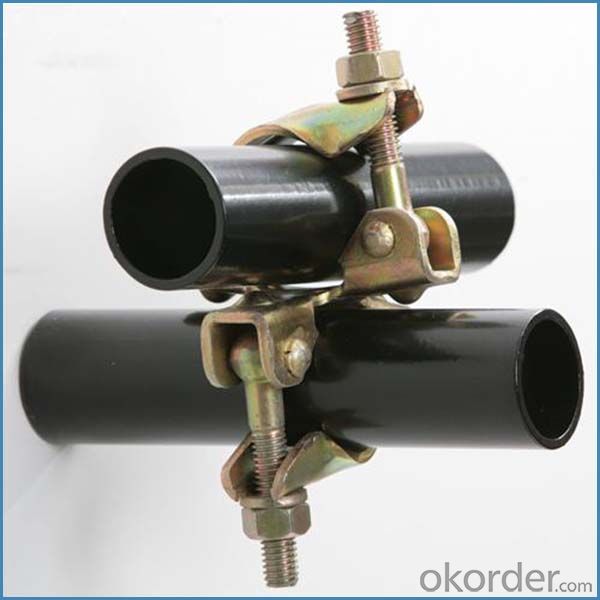
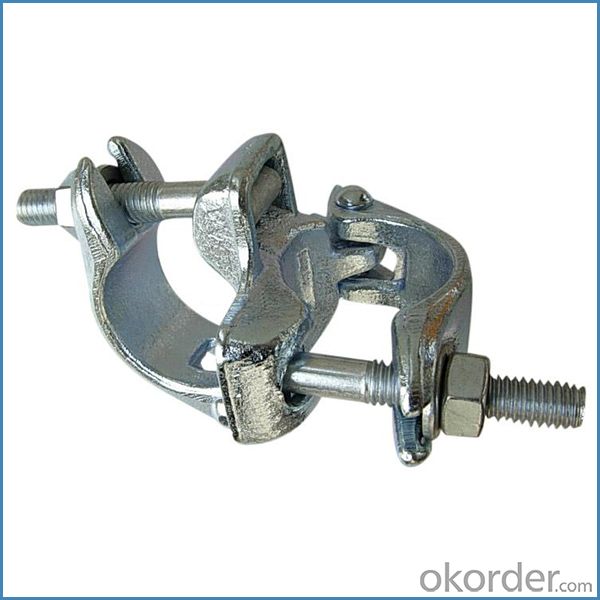
Parameter
| Material | Q235,345steel |
| Size | 48.3mm*48.3mm |
| Surface finish | Galvanized |
| Weight | 1.1kg around |
| Standard | BS1139,EN74 |
| Package | 25pcs/bag,steel pallet |
| Manufacture | As per customer requirement |
| Market | Africa, South America, the Middle East and Asia |
FAQ
Q: Are you a factory or trading company?
We are a state-owned corporation in China,dealing with various kinds of building materials.We have our holding subsidiaries.
Q: Where is your factory located? How can I visit there?
Our factory is located all around China.
Q: Can I get some samples?
Sample is free, customer only pay freight for the first time.
Q: Delivery?
10-30days. (5-15 containers)
Any question,feel free to contact us.
- Q: Are there any specific regulations or standards for the use of steel tube couplers in scaffolding?
- Yes, there are specific regulations and standards for the use of steel tube couplers in scaffolding. These regulations ensure the safety and structural integrity of scaffolding systems. Standards such as EN 74 and BS 1139 outline the requirements for coupler design, materials, load capacities, and installation procedures. Compliance with these standards is crucial to maintain the safety of workers and prevent accidents on construction sites.
- Q: Can steel tube couplers be used for scaffolding structures that need to support heavy loads at different heights?
- Yes, steel tube couplers can be used for scaffolding structures that need to support heavy loads at different heights. Steel tube couplers are specifically designed to provide a secure and reliable connection between scaffolding tubes, ensuring stability and strength. They are capable of withstanding the weight and pressure exerted by heavy loads, making them suitable for scaffolding structures that require support at varying heights.
- Q: Are there any specific guidelines for the safe use of steel tube couplers in scaffolding near moving machinery or vehicles?
- Yes, there are specific guidelines for the safe use of steel tube couplers in scaffolding near moving machinery or vehicles. Here are some key points to consider: 1. Risk Assessment: Before starting any work near moving machinery or vehicles, it is essential to conduct a thorough risk assessment. This assessment should identify potential hazards and the necessary control measures to mitigate them. 2. Distance: Maintain a safe distance between the scaffolding and moving machinery or vehicles. The exact distance will depend on the specific circumstances, including the size and speed of the machinery/vehicle and the nature of the work being carried out. Ensure that there is enough clearance to prevent accidental contact. 3. Barrier Systems: Implement effective barrier systems to prevent unauthorized access to the scaffolding area and to protect workers from potential hazards. These barriers should be sturdy and clearly marked, providing a visible and physical barrier between the scaffolding and moving machinery/vehicles. 4. Communication: Establish clear communication channels and protocols between workers on the scaffolding and operators of moving machinery/vehicles. This can be achieved through the use of radios, hand signals, or other suitable means. Regular communication is crucial to ensure everyone's safety. 5. Training and Competency: Ensure that workers involved in the erection, modification, or dismantling of scaffolding near moving machinery/vehicles are adequately trained and competent. They should have a good understanding of the risks involved, safe practices to follow, and emergency procedures. 6. Personal Protective Equipment (PPE): Workers should wear appropriate PPE, including high-visibility clothing, hard hats, safety glasses, and steel-toed boots. This will help to enhance visibility, protect against falling objects, and reduce the risk of injury. 7. Regular Inspections: Conduct regular inspections of the scaffolding, steel tube couplers, and the surrounding area to identify any signs of damage, wear, or instability. Any issues should be promptly addressed and rectified before work resumes. 8. Compliance with Standards and Regulations: Adhere to local regulations, industry standards, and manufacturer's guidelines when using steel tube couplers in scaffolding near moving machinery or vehicles. These guidelines are in place to ensure the safety of workers and minimize the risk of accidents. Remember, safety should always be the top priority when working near moving machinery or vehicles. By following these guidelines and implementing appropriate control measures, the risk of accidents can be significantly reduced.
- Q: I really want to get my Scaffold re pierced, it's only one hole that needs to be re pierced I think but the other hole was where it kinda rejected (used to always get infected, never properly healed after 3 years, used to always get ear infections because of it) it's also left a small keolid scar. Wondering if it's safe to re pierce?
- No do not get it pierced by any means if it keeps getting rejected after a whole 3 years I wouldn't dare try to get it pierced it would get infected again and probably worst could happen
- Q: Are there any special considerations when using steel tube couplers in extreme weather conditions?
- Yes, there are special considerations when using steel tube couplers in extreme weather conditions. Steel is susceptible to changes in temperature, so in extreme cold or hot weather, the couplers may expand or contract, potentially affecting their structural integrity. It is important to choose couplers that are specifically designed to withstand the anticipated weather conditions and to monitor their performance closely to ensure their continued safety and functionality. Additionally, protective measures such as insulation or coatings may be necessary to minimize the impact of extreme weather on the couplers.
- Q: Can steel tube couplers be used for scaffolding structures with uneven ground surfaces?
- Scaffolding structures with uneven ground surfaces can indeed utilize steel tube couplers. The versatility of these couplers enables them to adapt to various angles and positions, thereby facilitating adjustments to counterbalance the unevenness. Moreover, the steel tube couplers' robustness and stability guarantee the security and safety of the scaffolding structure, even in the presence of irregular terrain. To ensure stability and safety in such circumstances, it is crucial to dedicate adequate care and attention to the scaffolding's design and installation.
- Q: How do you dismantle and remove steel tube couplers from scaffolding?
- In order to dismantle and eliminate steel tube couplers from scaffolding, a systematic approach and a few tools are required. The steps involved are as follows: 1. Gather the necessary tools: Make sure to have a hammer, a wrench, and a scaffold spanner. It is important to ensure that the sizes of these tools match the couplers being worked with. 2. Evaluate the scaffolding structure: Prior to commencing the dismantling process, assess the scaffolding structure to identify the couplers that need to be removed. Take note of their positions and understand their connections to the tubes. 3. Loosen the coupler nuts: Use a scaffold spanner or wrench to loosen the nuts that secure the couplers to the tubes. Turn them in a counterclockwise direction to release their grip. In cases where the nuts are stuck or rusted, tapping the spanner gently with a hammer may be necessary to loosen them. 4. Remove the coupler nuts: Once the nuts are loosened, carefully unscrew them completely and set them aside. Exercise caution to avoid dropping them, as they could be lost or cause injury if they fall from a height. 5. Separate the scaffolding tubes: With the nuts removed, the scaffolding tubes can now be separated by pulling them apart. It may be necessary to wiggle or twist the tubes slightly to overcome any residual friction. 6. Extract the couplers: After separating the tubes, the couplers can now be removed from the scaffolding structure. Firmly grasp the coupler and gently tap it from the side or underneath with a hammer to dislodge it. If required, use a pair of pliers to provide additional leverage. 7. Repeat the process: Repeat this process for each coupler that needs to be removed from the scaffolding structure. Take your time to ensure that each step is executed safely and efficiently. 8. Inspect and replace: After removing the couplers, inspect them for any damage or signs of wear. If any couplers are broken or show deterioration, they should be replaced before reassembling the scaffolding. It is important to prioritize safety when working with scaffolding. Ensure that the structure is stable and secure, wear appropriate personal protective equipment, and adhere to any specific guidelines provided by the manufacturer or your supervisor.
- Q: Do steel tube couplers require any special tools for installation?
- No, steel tube couplers do not require any special tools for installation. These couplers are designed to easily connect two steel tubes together without the need for welding or other complex procedures. They typically feature a simple design with threaded ends that can be easily tightened by hand or with basic tools such as a wrench. This makes them convenient and straightforward to install, allowing for quick and efficient connections in various applications.
- Q: Brackets Cast-in-place beam support must be used with bowl button scaffolding, can not use fastener scaffolding, there is no mandatory, or standard file requirements!
- Fastener steel scaffolding of the wall pieces should not be embedded in the concrete floor inside
- Q: Can steel tube couplers be used in scaffolding systems with curved or irregular shapes?
- Yes, steel tube couplers can be used in scaffolding systems with curved or irregular shapes. These couplers are designed to provide a strong and secure connection between tubes, allowing for flexibility in creating scaffolding structures that can adapt to different shapes and angles.
Send your message to us
Heavy Duty Swivel Coupler British Type for Sale
- Loading Port:
- Tianjin
- Payment Terms:
- TT OR LC
- Min Order Qty:
- 1000 kg
- Supply Capability:
- 100000 kg/month
OKorder Service Pledge
OKorder Financial Service
Similar products
Hot products
Hot Searches
